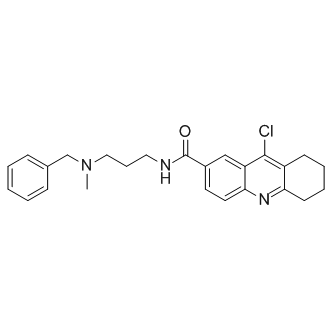| Description |
HBX 19818 is a specific inhibitor of ubiquitin-specific protease 7 (USP7), with an IC50 of 28.1 μM.
|
| Related Catalog |
|
| Target |
IC50: 28.1 μM (USP7)[1]
|
| In Vitro |
HBX 19818 is an inhibitor of USP7, with an IC50 of 28.1 μM. HBX 19818 shows no effects on USP8, USP5, USP10, CYLD, UCH-L1, UCH-L3 or on SENP1, a SUMO protease, with IC50s of > 200 μM. HBX 19818 selectively inhibits USP7 with IC50 of ∼6 μM in in human cancer cells. In addition, HBX 19818 (1.5, 4, 12, 36, or 100 μM) inhibits USP7 deubiquitination of polyubiquitinated p53. HBX 19818 (30 μM) also causes significantly higher levels of Mdm2 polyubiquitinated forms in USP7-overproducing HEK293 cells than those in DMSO-treated control cells. HBX 19818 inhibits HCT116 proliferation in a dose-dependent manner, with an IC50 of ∼2 μM[1].
|
| Kinase Assay |
The ability of HBX 19818 and HBX 28,258 to inhibit a panel of deubiquitinating enzymes, including UCH-L3 (13 pM), USP7 (100 pM), USP8 (1.36 nM), UCH-L1 (2.5 nM), USP5 (10 nM), USP20 (10 nM), and USP2 (500 pM), is tested using the UbAMC substrate (300 nM). The potential effects of HBX 19818 and HBX 28,258 are also tested on the enzymatic activities of SENP1 (80 pM), cathepsin-B (100 pM), and caspase-3 (100 pM) using the SUMO1-AMC (750 nM), ZRR-AMC (3 μM), and DEVD-AMC (250 nM) substrates, respectively. All enzymes are tested in USP7 reaction buffer (50 mM Tris-HCl [pH 7.6], 0.5 mM EDTA, 5 mM DTT, 0.01% Triton X-100, and 0.05 mg/mL serum albumin), except for two enzymes, USP8 (same buffer but pH 8.8) and caspase-3 (100 mM HEPES [pH 7.5], 10% sucrose, and 0.1% CHAPS). All enzymes are pre-incubated with DMSO or compounds (including HBX 19818) for 30 min at room temperature, and the enzymatic reaction is initiated by adding the substrate of interest. The reaction mixture is incubated at room temperature for 1 hr, and the reaction is stopped by adding acetic acid (100 mM). The reactions are monitored using the PHERAstar[1].
|
| Cell Assay |
HCT116 cell proliferation is evaluated by incubating HCT116 cells for 30 min in culture medium containing 10 µM 5- bromo-2-deoxyuridine (BrdU), which is incorporated into the DNA of proliferating cells. Cells are then harvested by trypsin treatment, collected by centrifugation, and the pellet is resuspended and incubated in 70% ethanol for 30 min at 4°C. After centrifugation and supernatant removal, DNA is denaturated by incubating it in 2 N HCl for 30 min at room temperature. The percentage of BrdU-containing cells is then determined by flow cytometry, making it possible to quantify proliferating cells. Cell cycle is evaluated after treatment with HBX 19818 for 24 hr, followed by fixing detached cells and trypsinized cells in 70% ethanol for 30 minutes at 4°C. Cells are then incubated in PBS supplemented with 1% BSA, 0.5% Tween 20, 50 µg/mL RNase A and 50 µg/mL propidiumiodide for 30 minutes at 37°C. Samples are analyzed on a FACSort fluorocytometer. The percentage of cells in the different phases of the cell cycle is calculated using Multicycle software[1].
|
| References |
[1]. Reverdy C, et al. Discovery of specific inhibitors of human USP7/HAUSP deubiquitinating enzyme. Chem Biol. 2012 Apr 20;19(4):467-77.
|
